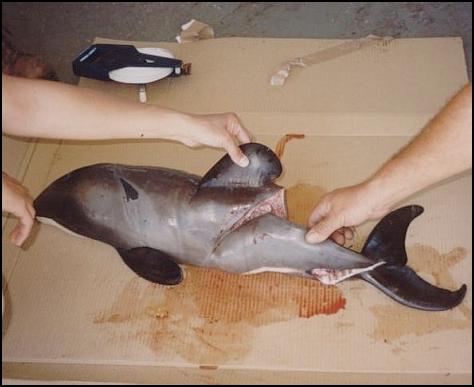NZ's marine mammals worse off than realised
5 November 2003 Media Statement

The Department of the Conservation and the fishing industry are to tackle a mounting threat to some of New Zealand's whale, dolphin and seal species, Conservation Minister Chris Carter announced today.
DoC is launching a public education poster this summer designed to highlight the plight of New Zealand's marine mammals, and it is developing, in consultation with the fishing industry and stakeholder groups, a new threat minimisation plan for whales, dolphins and seals.
"New Zealand is lucky enough to have more marine mammal species living in its waters than any where else in the world, " Mr Carter said.
"But new information gathered by DoC over the past year suggests recent human impact on some of these species, particularly whales, may be worse than we previously thought, and if we are not very careful it may be about to get worse still.
"Figures collated by DoC show at least six whales have been struck and killed by container ships in the Hauraki Gulf in the past few years. At least four humpback whales have become entangled in cray pot lines in the past three years, and several whales have drowned after getting caught up in marine farm ropes.
"To make matters worse, new research conducted on the southern right whale in March has found that there may be less than 11 breeding females left in the population that lives around mainland New Zealand," Mr Carter said.
"A major potential threat to the southern right whale is believed to be the gradual erosion of their coastal habitat by marine farming, and the prospect of entanglement in those activities. At present we have about 7500 hectares of marine farms in place with another 55,000 hectares in the pipe line. We must plan these farms very carefully or we could lose another species from our seas.
"Unfortunately, the killing of marine mammals doesn't stop with whales, Mr Carter said.
"Although we have long since ceased sealing in New Zealand, hundreds of fur seals are still being accidentally killed by trawlers in our waters each year and about 60 of the rare New Zealand (or Hooker's) sea lion are still being caught by our fisheries annually," Mr Carter said.
"In recognition of these kinds of impacts on some of our most spectacular marine creatures, DoC is to work with the fishing industry to tackle the problem.
"Fisheries make an important contribution to our economy but we must strive to ensure they do not harm the extraordinary range of marine mammals that New Zealand is fortunate enough to have. I am confident that by co-operation we can find acceptable ways to reduce marine mammal deaths as we have with the industry partnership on seabirds," Mr Carter said.
He said DoC was also calling on recreational fishers, boat owners, port companies and local councils to work towards better marine mammal protection.
"A key way everyone who works or plays in the marine environment can help marine mammals is by eliminating the dumping of rubbish at sea that is hazardous to dolphins, seals and even whales. Just yesterday, I learned a killer whale has been found starved to death after a recreational fisherman's berley bag got caught in its throat. I don't think anyone thinks this kind of cruel death is acceptable and it is happening too often," Mr Carter said.
ENDS
Pics of marine mammals killed in fishing and boating related activities available.
Key Facts on Marine Mammals:
- 50 species of marine mammal live in New Zealand's waters
- Over half the species of the world's whales are seen around New Zealand's coast.
- Humpback whales are at about 5% of their population size prior to whaling.
- Less than 100 Maui's dolphins are left.
- Fur seals are at about 10% of their population prior to the start of sealing, although their population is now believed to be increasing.
- The New Zealand sealion, found no where else in the world, is restricted to a fraction of its former range - the subantarctic Auckland and Campbell Islands – after sealing cleaned them out of mainland waters.
- Southern Right Whales in New Zealand waters are
believed to comprise less than 30 animals, and are
completely separate from the Australian and sub Antarctic
populations. No southern right whales were seen around NZ
from the 1930s to 1963, so this could be a tentative and
fragile recovery.


 Gordon Campbell: On The Clash Between Auckland Airport And Air New Zealand
Gordon Campbell: On The Clash Between Auckland Airport And Air New Zealand Organics Aotearoa NZ: Gene Tech Bill - A High-Stakes Gamble That Risks Farmers’ Livelihoods, Trade, And NZ’s Global Reputation
Organics Aotearoa NZ: Gene Tech Bill - A High-Stakes Gamble That Risks Farmers’ Livelihoods, Trade, And NZ’s Global Reputation Fire and Emergency NZ: Check Your Smoke Alarms When Clocks Go Back This Sunday
Fire and Emergency NZ: Check Your Smoke Alarms When Clocks Go Back This Sunday NZ Government: Repeal Of 7AA Puts Child Wellbeing First
NZ Government: Repeal Of 7AA Puts Child Wellbeing First NZ Government: Reducing Ambiguity About What Is Reasonably Practicable For Health And Safety Compliance
NZ Government: Reducing Ambiguity About What Is Reasonably Practicable For Health And Safety Compliance Office of the Speaker: New Zealand Parliamentarians Attend 150th IPU Assembly
Office of the Speaker: New Zealand Parliamentarians Attend 150th IPU Assembly RNZRSA: RNZRSA Supports Willie Apiata VC's Stand To Drive Change To Veterans’ Support Act
RNZRSA: RNZRSA Supports Willie Apiata VC's Stand To Drive Change To Veterans’ Support Act


